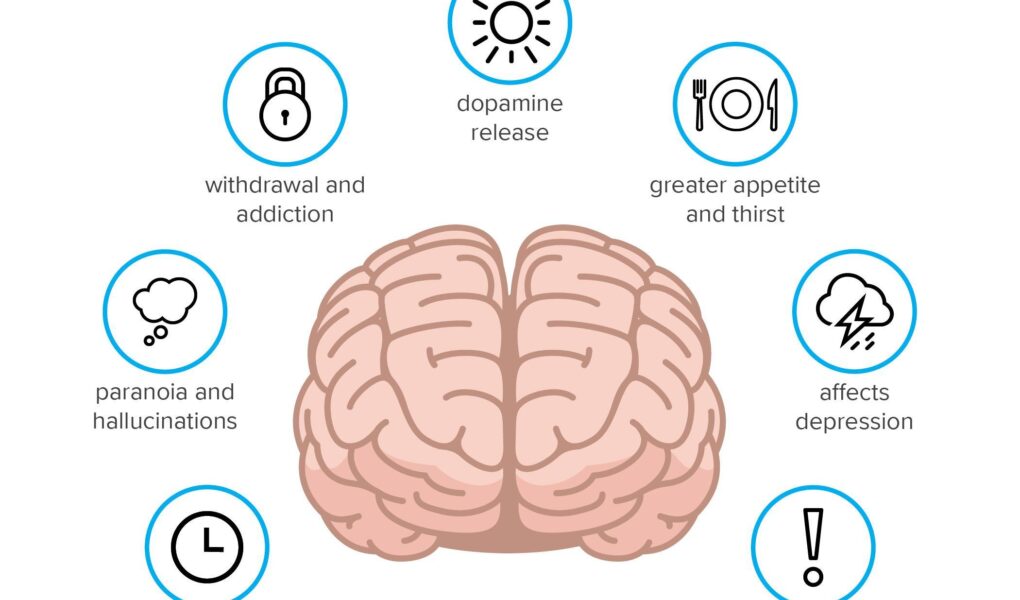In recent years, the conversation around marijuana has evolved from hushed whispers in back rooms to bold discussions in public forums. As more regions embrace legalization, the multifaceted implications of cannabis consumption are gaining traction—from its potential therapeutic benefits to the lingering questions surrounding its health effects. Among these, the impact of smoking marijuana emerges as a particularly complex topic. While some espouse its use for relaxation and relief, others voice concerns about the potential risks to physical and mental well-being. This article aims to illuminate the nuanced landscape of marijuana smoke, examining its effects through a balanced lens to better inform those caught in the haze of misinformation. Join us as we explore the science behind marijuana use, the health ramifications it entails, and the ongoing dialogue that shapes our understanding of this age-old herb.
Table of Contents
- Exploring the Impact of Marijuana on Lung Health
- The Psychological Dimensions: Marijuana and Mental Well-Being
- Understanding the Role of Cannabinoids in Pain Management
- Navigating Responsible Use: Recommendations for Smokers
- Q&A
- To Wrap It Up
Exploring the Impact of Marijuana on Lung Health
The relationship between marijuana and lung health has garnered increasing attention from researchers and health professionals alike. While some advocate for its potential therapeutic benefits, it is crucial to consider the effects that smoking marijuana may have on the respiratory system. When marijuana is inhaled, it can introduce various compounds, including tar and other irritants, which may lead to inflammation in the airways. Over time, this can result in symptoms such as chronic cough, phlegm production, and wheezing. While some studies suggest that moderate use might not lead to severe damage, particularly when compared to tobacco, the long-term consequences on lung function remain unclear.
Furthermore, understanding the delivery method is essential for assessing the impact on lung health. For instance, the use of vaporization or edibles could mitigate some negative effects associated with traditional smoking. The following table summarizes common methods of consumption and their potential implications for lung health:
| Consumption Method | Potential Lung Health Impact |
|---|---|
| Smoking (Joints, Blunts) | Inhalation of irritants/tars, potential for chronic bronchitis |
| Vaporization | Reduced exposure to harmful byproducts; less irritation |
| Edibles | No respiratory exposure; bypasses lung risks |
| Concentrates (Oils) | Higher potency; potential respiratory issues if smoked |
The Psychological Dimensions: Marijuana and Mental Well-Being
The intricate relationship between marijuana and mental well-being is a topic of ongoing research and debate. Many users report experiencing elevated mood, increased creativity, and a sense of relaxation after consuming cannabis. However, the effects of marijuana on mental health can vary significantly from one individual to another, influenced by factors such as dosage, strain, and personal predisposition. While some may find relief from symptoms of anxiety or depression, others might experience paranoia, anxiety spikes, or deteriorating cognitive function. This duality makes it essential to approach cannabis use with an awareness of its psychological implications.
Additionally, ongoing studies have suggested a potential link between cannabis use and long-term mental health disorders. For example, chronic use has been associated with an increased risk of schizophrenia and other psychotic disorders, particularly in individuals with a genetic predisposition to these conditions. It is vital to consider various aspects of usage, such as:
- Frequency of use: Daily users may face different psychological outcomes than occasional users.
- Age of first use: Early exposure in adolescence could lead to heightened risks.
- Type of strain: Indica strains may produce calming effects, while sativa strains could lead to increased anxiety in some users.
Table of Considered Effects:
| Effect | Potential Outcome |
|---|---|
| Elevated Mood | Higher satisfaction and creativity |
| Paranoia | Increased anxiety and fear |
| Relaxation | Decreased stress levels |
| Cognitive Impairment | Difficulty with attention and memory |
Understanding the Role of Cannabinoids in Pain Management
Recent studies have illuminated the complex interactions between cannabinoids and the human endocannabinoid system, revealing significant implications for pain relief. Cannabinoids, specifically tetrahydrocannabinol (THC) and cannabidiol (CBD), are compounds found in marijuana that interact with cannabinoid receptors in the brain and body. This interaction can modulate pain signaling pathways, leading to a decrease in sensations of pain. Patients seeking alternative therapies often report notable improvements in conditions such as chronic pain, neuropathy, and arthritis when using cannabinoid-rich products.
When considering cannabinoids for pain management, it’s essential to understand the varying effects of different strains and formulations. Here are some key points to consider:
- THC: Known for its psychoactive properties, THC can provide significant pain relief but may also induce anxiety or paranoia in some users.
- CBD: Non-psychoactive and often favored for its calming effects, CBD has gained popularity for its anti-inflammatory properties.
- Entourage Effect: The synergistic relationship between various cannabinoids and terpenes can enhance therapeutic effects, potentially leading to more effective pain management.
| Type of Cannabinoid | Primary Effects |
|---|---|
| THC | Analgesic, psychoactive |
| CBD | Anti-inflammatory, non-psychoactive |
| CBG (Cannabigerol) | Potential anti-inflammatory and pain relief |
Navigating Responsible Use: Recommendations for Smokers
For those who choose to smoke marijuana, understanding the implications for health and well-being is essential. Implementing responsible practices can mitigate some of the potential risks associated with consumption. Here are a few recommendations to consider:
- Limit Frequency: Reducing the number of sessions per week can help minimize the impact on lung health and cognitive function.
- Opt for Quality: Prioritize high-quality, regulated products to avoid harmful additives and contaminants.
- Hydrate Often: Staying hydrated can alleviate some of the discomforts such as dry mouth and throat irritation that accompany smoking.
- Mindful Consumption: Take time to understand personal reactions to different strains, adjusting choices accordingly for optimal experiences.
Moreover, it is beneficial to stay informed on the various methods of consumption that may have lesser health impacts than traditional smoking. Here’s a quick comparison of some alternatives:
| Method | Health Impact |
|---|---|
| Smoking | Highest risk for lung irritation and other respiratory issues. |
| Vaping | Lower risk, but still not without health concerns. |
| Edibles | Minimal lung impact; effects can vary widely and take longer to onset. |
| Tinctures | Effective alternative with precise dosing; avoids respiratory issues. |
Q&A
Q&A: Health Effects of Smoking Marijuana
Q: What are the primary health effects of smoking marijuana?
A: Smoking marijuana can have a variety of health effects that vary from person to person. Short-term effects may include increased heart rate, dry mouth, and altered cognitive function, which can affect memory and coordination. Long-term use can contribute to respiratory issues, similar to tobacco, due to the inhalation of smoke.
Q: How does smoking marijuana affect mental health?
A: The relationship between marijuana use and mental health is complex. Some individuals report feelings of relaxation and euphoria, while others may experience anxiety or paranoia. Long-term use, especially in predisposed individuals, may increase the risk of developing mood disorders or psychosis.
Q: Are there any potential benefits associated with smoking marijuana?
A: While illegal in many places, marijuana has shown therapeutic potential for certain conditions when smoked or consumed in other forms. Some users find relief from chronic pain, nausea from chemotherapy, and symptoms of multiple sclerosis. However, these benefits must be weighed against potential risks.
Q: Can smoking marijuana impact lung health similarly to tobacco?
A: Yes, smoking marijuana can be harmful to lung health. The smoke contains irritants and carcinogens, which can lead to chronic cough and bronchitis over time. However, some studies suggest that occasional marijuana use may not have the same degree of risk as long-term tobacco smoking.
Q: Is there a difference in health effects when comparing smoking marijuana to other consumption methods?
A: Absolutely! Vaporizing, edibles, and oils can reduce some respiratory risks associated with smoking. Each method has its own onset time and duration of effects, and they can interact differently with the body’s system. Edibles, for instance, take longer to onset and may lead to stronger psychoactive effects if dosages are misjudged.
Q: How does marijuana smoke affect the cardiovascular system?
A: Smoking marijuana temporarily increases heart rate, which can pose risks for people with existing heart conditions. Additionally, the smoke contains carbon monoxide and other harmful substances that could adversely affect cardiovascular health over time.
Q: Are there age-related concerns with smoking marijuana?
A: Yes, adolescents and young adults may be particularly vulnerable to the negative cognitive effects of marijuana, as their brains are still developing. Research indicates that early and consistent use can impair learning and memory, and could potentially lower academic performance.
Q: What should users know about the legal status of marijuana and health implications?
A: The legal status of marijuana varies greatly by region, influencing both its availability and research on its health effects. Users should be aware that impaired judgment and potential criminal consequences exist, alongside health risks. Informing oneself on local laws and regulations can be crucial to safe and legal usage.
Q: What steps can be taken to minimize health risks if someone chooses to smoke marijuana?
A: Potential users can minimize risks by opting for moderation, choosing safer consumption methods (like vaporizers), and using high-quality products. It’s also wise to consult a healthcare provider, especially for those with pre-existing conditions or those taking other medications.
Q: Where can one find more information on the health effects of smoking marijuana?
A: Reliable resources include educational websites like the CDC, NIH, and various health organizations. Additionally, conversations with healthcare professionals can provide personalized insights and guidance on the implications of marijuana use.
To Wrap It Up
the health effects of smoking marijuana present a complex tapestry woven from both potential benefits and risks. As we navigate this evolving landscape, it becomes essential to approach the subject with an open mind and a critical eye. For some, marijuana offers relief from chronic pain, anxiety, and various medical conditions, while for others, it may lead to respiratory issues and cognitive challenges. Ultimately, informed choices and responsible usage are paramount.
As society continues to explore the implications of marijuana use, both recreationally and medicinally, ongoing research and dialogue will be crucial. Whether you’re considering a puff for relaxation or exploring its therapeutic potential, understanding the nuanced effects on your health can empower you to make decisions that align with your individual needs and values. The journey toward clarity on this topic is just beginning, inviting us all to stay curious, stay informed, and above all, maintain our commitment to well-being.



